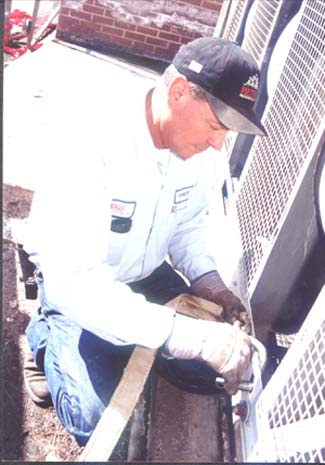

The upgraded cooling systems are a conversion from Freon application to water chilled cooling systems. According to Carl Triphahn, executive director of P.I.P.E. (The Piping Industry Progress and Education Trust Fund), the economical advantages and energy efficiency of a water chilled cooling system can be significant, especially in a market like Phoenix, where there is such a high demand for energy throughout the summer and fall months.
"P.I.P.E. believes it is important for the managers and owners of 20-to-30-year-old commercial and large residential buildings in the Phoenix area to evaluate the buildings' current air conditioning systems," Triphahn said. "Upgading the old freon systems prevents the types of energy problems we are seeing in other parts of the country, particularly California."
Rick Wieting, service manager for W.D. Manor Mechanical Contractors, Inc., a P.I.P.E. contractor, concurred.
"Without some concerns on the part of the 'high energy user,' even though they are willing to pay the premium price, Arizona will end up short of power," Wieting explained. "Especially without the construction of new power generating stations."
Ian T. Hadden, a Phoenix-based sales engineer for York International Corporation, said manufactures have taken the need for more energy-efficient products into consideration for new models and designs.
"The technology we have available to us today is far superior to what we have had in the past," Hadden said. "Over the last 20 years, we have gotten much smarter on how and why an hvac system operates the way it does. That has resulted in at least a 20 percent increase in efficiency."
Manufacturers of chillers have begun using different refrigerants for higher performance, along with the use of variable speed drives for higher efficiency load control, rather than limiting the refrigerant cycle. This adjustment in the manufacturers' approach will make installations of new systems in Phoenix and across the country, more energy efficient and environmentally friendly.
Lou Jennings, vice president of Metro Mechanical, a P.I.P.E. contractor, said it is important for building owners to realize that these hvac systems are generally complex and require highly trained craftspeople to ensure that any retrofit upgrade work is done correctly.
He said each HVAC system upgrade must be well thought-out and customized to ensure maximum efficiency, reliability and long-range environmental safety.
"It's not like a delivery man dropping off a new reftigerator," Jennings said. "We have to learn about the usage of the building, evaluate the overall condition of the existing system, and then make retrofit suggestions accordingly.
"As an example, the chiller is certainly central to the hvac system, but there are many other system components which may greatly impact the performance. For instance, variable water pumping is a good way to realize energy savings," Jennings continued. "Also, a plate and frame heat exchanger allows for nearly 'free cooling' during mild and winter seasons. Top-notch energy management control systems are available to coordinate all of the system events and even let the owner or contractor know when something is not working properly. These types of considerations should be addressed during the upgade-project design. At Metro Mechanical, we ask many questions, and then listen closely to the answers."
Jennings also said the typical industrial chiller will have a 15-to-20-year lifespan if it is cared for properly.
"It is imperative to have qualified craftspeople service and maintain these industrial cooling svstems," Jennings explained. "There is too much at stake for most companies to have air conditioning problems that cause interruptions in their businesses."
U.A. Local 469, the plumbers, pipefitters, and steamfitters union, is one such business that has recognized the need to upgrade its air conditioning system.
"About 15 years ago, Local 469 saw the advantages and modified its air conditioning system, going from direct expansion to a chilled water system," Mike Van Kirk, Metro Mechanical's operations and service manager, said. "With the chilled water system currently in use at the union hall approaching the end of its lifespan, the union has decided to upgrade to a new, energy efficient chiller. The union is also installing a more energy efficient cooling tower, and a microprocessor-based energy management system to minor and modify the building's energy usage."
Van Kirk said changes like this, many of which are currently underway at buildings ranging from hospitals and churches to warehouses, manufacturing, and aerospace facilities, will hopefully have a positive impact on our energy supply in the months ahead.

Publication date: 06/18/2001

Report Abusive Comment